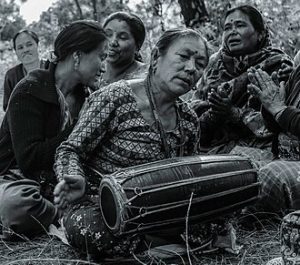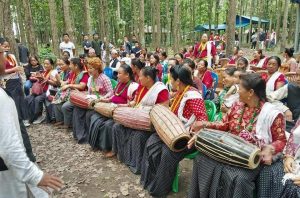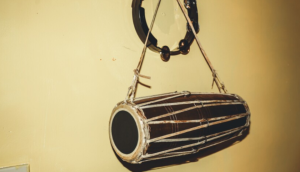Madal: The National Drum of Nepal
The *Madal* is a traditional Nepali percussion instrument, widely regarded as the *national drum of Nepal*. It is a double-headed hand drum, played horizontally, and is central to Nepali folk and classical music. The Madal is known for its distinctive rhythmic patterns and is used in various cultural, religious, and social occasions.
1. History of Madal in Nepal
The Madal has deep roots in Nepali culture, with its origins tracing back to ancient times.

“Nepali woman playing maadal
Early Origins
– The Madal is believed to have been influenced by similar drums from India (such as the Mridangam and Pakhavaj) and Tibet (Damphu).
– It was historically played by the *Magar, Gurung, and Kirati* communities, who used it in rituals and folk dances.
Development in Nepali Society:
– During the Lichhavi period (400-750 AD), musical instruments like Madal gained prominence in royal courts and religious ceremonies.
– By the Malla period (1200-1768 AD), the Madal became an essential part of Newari and other ethnic music traditions.
– In modern Nepal, it is widely used in folk songs (lok geet), classical music, and even contemporary music.
Symbol of National Identity:
– The Madal is considered a unifying instrument, played across various ethnic groups in Nepal.
– It is often associated with *Nepali rural life, festivals, and cultural heritage*.
2. Structure and Types of Madal
The Madal is a cylindrical drum with two heads, made from natural materials.
A. Construction:
– Body (Ghar): Traditionally made from hardwood (Saal, Saj, or Khirro), though modern versions may use metal or synthetic materials.
– Heads (Mukh): Made from goat or buffalo hide, stretched and tightened with leather straps.
– Black Paste (Khari): A mixture of iron filings, rice paste, and resin applied to the heads to produce a deep, resonant sound.
– Tuning Straps (Tuna): Leather straps used to adjust tension and pitch.

The Madal has deep roots in Nepali culture, with its origins tracing back to ancient times.
B. Types of Madal:
1. Traditional Madal (Lok Madal)
– Used in folk music.
– Larger in size with a deep, bass-heavy tone.
2. Classical Madal (Shastriya Madal
– Smaller and more refined.
– Used in classical and devotional music.
3. Modern Madal
– Made with synthetic materials for durability.
– Used in fusion and contemporary music.
3. Playing Technique and Rhythms
– Holding Position: Placed horizontally on the lap or held with a strap around the neck.
– Hand Techniques:
– Right Hand: Plays the “Dha” (bass) side.
– Left Hand: Plays the “Ti” (treble) side.
– Common Rhythms (Taal):
– Sorathi Taal (6-beat cycle)
– Jhyaure Taal (8-beat cycle)
– Khyali Taal (used in love songs)
4. Importance of Madal in Nepali Culture

The Madal is known for its distinctive rhythmic patterns and is used in various cultural, religious, and social occasions.
– Folk Music & Dance: Essential in Jhyaure, Sorathi, and Deuda dances.
– Religious Ceremonies: Used in bhajans (devotional songs) and temple rituals.
– Social Gatherings: Played at weddings, festivals (Dashain, Tihar), and cultural events.
– National Identity: Symbolizes Nepali tradition and is taught in music schools worldwide.
5. Famous Madal Players in Nepal
– Narayan Gopal (Legendary singer who popularized Madal in modern music)
– Jhalak Man Gandarbha (Renowned folk Madal player)
– Krishna Pariyar (Madal maestro in classical music)
Conclusion
The Madal is more than just a musical instrument—it is a cultural emblem of Nepal. From ancient rituals to modern concerts, its rhythmic beats continue to define Nepali music. Whether in villages or cities, the Madal remains a vital part of Nepal’s artistic heritage, preserving traditions while evolving with contemporary sounds.


